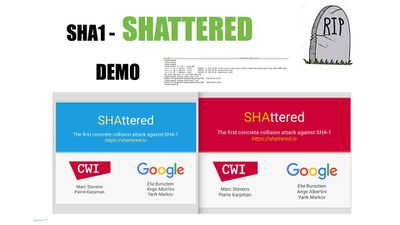Collision attack

Collision Attack on a cryptographic hash tries to find two inputs producing the same hash value, i.e. a hash collision. This is in contrast to a preimage attack where a specific target hash value is specified.
There are roughly two types of collision attacks
- Collision attack: Find two different messages m1 and m2 such that hash(m1) = hash(m2).
More generally
- Chosen-prefix collision attack: Given two different prefixes p1 and p2, find two appendages m1 and m2 such that hash(p1 ∥ m1) = hash(p2 ∥ m2), where ∥ denotes the operation.
Contents
Classical collision attack
Mathematically stated, a collision attack finds two different messages m1 and m2, such that hash(m1) = hash(m2). In a classical collision attack, the attacker has no control over the content of either message, but they are arbitrarily chosen by the algorithm.
Much like symmetric-key ciphers are vulnerable to brute force attacks, every cryptographic hash function is inherently vulnerable to collisions using a birthday attack. Due to the birthday problem, these attacks are much faster than a brute force would be. A hash of n bits can be broken in 2n/2 time (evaluations of the hash function).
More efficient attacks are possible by employing cryptanalysis to specific hash functions. When a collision attack is discovered and is found to be faster than a birthday attack, a hash function is often denounced as “broken”. The NIST hash function competition was largely induced by published collision attacks against two very commonly used hash functions, MD5 and SHA-1. The collision attacks against MD5 have improved so much that, as of 2007, it takes just a few seconds on a regular computer. Hash collisions created this way are usually constant length and largely unstructured, so cannot directly be applied to attack widespread document formats or protocols.
However, workarounds are possible by abusing dynamic constructs present in many formats. In this way, two documents would be created which are as similar as possible in order to have the same hash value. One document would be shown to an authority to be signed, and then the signature could be copied to the other file. Such a malicious document would contain two different messages in the same document, but conditionally display one or the other through subtle changes to the file:
- Some document formats like PostScript, or macros in Microsoft Word, have conditional constructs. (if-then-else) that allow testing whether a location in the file has one value or another in order to control what is displayed.
- files can contain cropped images, with a different part of an image being displayed without affecting the hash value.
A real-world collision attack was published in December 2008 when a group of security researchers published a forged X.509 signing certificate that could be used to impersonate a certificate authority, taking advantage of a prefix collision attack against the MD5 hash function. This meant that an attacker could impersonate any SSL-secured website as a man-in-the-middle, thereby subverting the certificate validation built in every web browser to protect electronic commerce. The rogue certificate may not be revokable by real authorities, and could also have an arbitrary forged expiry time. Even though MD5 was known to be very weak in 2004, and at least one Microsoft code-signing certificate was still using MD5 in May 2012.
The Flame malware successfully used a new variation of a chosen-prefix collision attack to spoof code signing of its components by a Microsoft root certificate that still used the compromised MD5 algorithm.
Attack scenarios
Many applications of cryptographic hash functions do not rely on collision resistance, thus collision attacks do not affect their security. For example, HMACs are not vulnerable. For the attack to be useful, the attacker must be in control of the input to the hash function.
Digital signatures
Because digital signature algorithms cannot sign a large amount of data efficiently, most implementations use a hash function to reduce (“compress”) the amount of data that needs to be signed down to a constant size. Digital signature schemes are often vulnerable to hash collisions, unless using techniques like randomized hashing.
The usual attack scenario goes like this:
- Mallory creates two different documents A and B that have an identical hash value, i.e., a collision. Mallory seeks to deceive Bob into accepting document B, ostensibly from Alice.
- Mallory sends document A to Alice, who agrees to what the document says, signs its hash, and sends the signature to Mallory.
- Mallory attaches the signature from document A to document B.
- Mallory then sends the signature and document B to Bob, claiming that Alice signed B. Because the digital signature matches document B’s hash, Bob’s software is unable to detect the substitution.
In 2008, researchers used a chosen-prefix collision attack against MD5 using this scenario, to produce a rogue certificate authority certificate. They created two versions of a TLS public key certificate, one of which appeared legitimate and was submitted for signing by the RapidSSL certificate authority. The second version, which had the same MD5 hash, contained flags which signal web browsers to accept it as a legitimate authority for issuing arbitrary other certificates.
See Also on BitcoinWiki
Source
https://changelly.com/blog/best-decentralized-crypto-exchanges-in-2019/